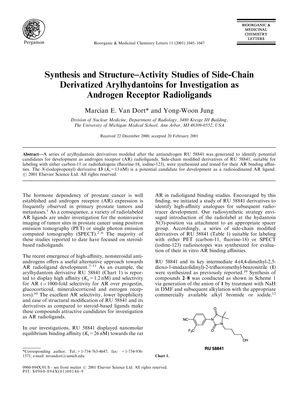Synthesis and Structure–Activity Studies of Side-Chain Derivatized Arylhydantoins for Investigation as Androgen Receptor Radioligands
April 2001
in “
Bioorganic & Medicinal Chemistry Letters
”

TLDR The nature of the side chain in RU 58841 derivatives greatly affects its AR affinity, with the N-(iodopropenyl) derivative 13 showing the highest AR binding affinity, suggesting its potential for developing high-affinity radioiodinated AR radioligands.
In 2001, researchers Marcian E. Van Dort and Yong-Woon Jung studied a series of arylhydantoin derivatives, based on the antiandrogen RU 58841, to find potential androgen receptor (AR) radioligands for noninvasive imaging of prostate cancer tumor sites. They found that the side chain nature in RU 58841 derivatives significantly influenced its AR affinity. Most alterations led to a decrease in AR affinity, rendering them unsuitable for AR radioligand development. However, the N-(iodopropenyl) derivative 13 demonstrated the highest AR binding affinity (K₁ = 13 nM), a 2-fold improvement over RU 58841, indicating its potential for high-affinity radioiodinated AR radioligand development.

